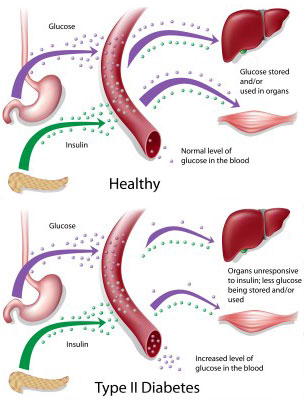
Daniel Seidler is the Executive Director of
WSPT. He is a
Columbia University graduate with a Masters in Physical
Therapy. His areas of expertise are aquatic therapy and
orthopedic manual physical therapy based on the Maitland
technique of assessment and treatment. Daniel is a
self-proclaimed fitness freak, having completed 3 NYC
marathons and the 2010 NYC Triathlon.
| |
|
How Physical
Therapy Can Help You Manage Type II Diabetes |

Type II Diabetes is usually a result of poor nutrition
combined with a lack of exercise or activity. The body’s
ability to produce insulin or use it to break down sugar
becomes compromised from being overworked for a prolonged
period of time. Some people are born with a predisposition
for acquiring Type II Diabetes, but ultimately it is a
preventable disease. For the same reasons, it also is
manageable to the point that it’s effects are minimal if
approached effectively.
If you do have diabetes, it’s important that you have a plan
and you stick with it. Complications from diabetes tend to
build and become more difficult to reverse over time. An
effective means of managing diabetes is to have a capable
health care team on your side to advise and work with you. A
good doctor, nurse, pharmacist, nutritionist and Physical
Therapist should all be on your speed dial if you have
diabetes. A Physical Therapist can be an extremely valuable
member of your team because of their knowledge, skills, and
accessibility.
Ways a Physical Therapist can help someone with Diabetes:
1. The key to managing diabetes is being able to balance
your blood-sugar levels. This can be accomplished through
proper nutrition, exercise and medication. By prescribing an
appropriate exercise program, a PT can be a vital piece of
the diabetes management puzzle. Diabetes has varying effects
on each person. Nutrition, exercise and medicine dosages
have different effects on every person. These effects even
change over time. By prescribing an appropriate exercise
program, a PT can help you effectively manage your sugar
levels and avoid many of the complications associated with
dips and spikes in blood-sugar levels.
2. Many people with diabetes are either physically
deconditioned or become less fit over time due to the
complications of the disease. Deconditioning leads to
additional complications and makes managing blood-sugar
levels extremely difficult. I often hear from people with
diabetes that they can’t exercise because they’re not in
good enough shape. I understand this and I also realize that
if you are obese, it may be painful to even walk due to
complications such as arthritis or back pain. PTs are very
experienced at working with people who have multiple
complications. Treating conditions like arthritis is the
norm for us, so we can help diabetics overcome the
roadblocks that are preventing them from starting an
exercise program. Once pain and orthopedic challenges are
addressed, patients with diabetes can get down to the
business of improving their overall heath.
3. One very serious effect of diabetes is diabetic
neuropathy. Neuropathy is due to poor circulation associated
with diabetes and results in pain, tingling, numbness and
other discomfort in the feet and hands. It can also
gradually spread more proximally up the limbs if not
addressed. This pain and altered sensation leads to
inactivity and feeds into the cycle of deconditioning
mentioned above. In addition, due to poor sensation, a
diabetic can easily injure, cut, or even puncture part of
their feet and not become aware of the injury unless he or
she is carefully inspecting their body.
A PT can help treat diabetic neuropathy with infrared light
modalities such as Anodyne Therapy combined with
massage,
aquatic therapy, balance/gait training, and general
conditioning. The first step is to get the diabetic patient
back on their feet and out of the cycle of pain and
inactivity. A PT uses their skills and motivation to make
this happen safely and effectively.
Since diabetes can potentially affect every system of the
body, the complications are potentially endless if not
managed appropriately. PTs are very knowledgeable in the
causes and effects of diabetes, so we have multiple
solutions to the problems that arise for diabetics. Every
patient is different, so we develop individual programs for
the complications that each person is coping with. If you
have diabetes or are pre-diabetic, it’s extremely important
that you address it immediately and a PT can be a beneficial
part of your team.
Last revised: December 4, 2011
by Daniel Seidler, MS, PT








